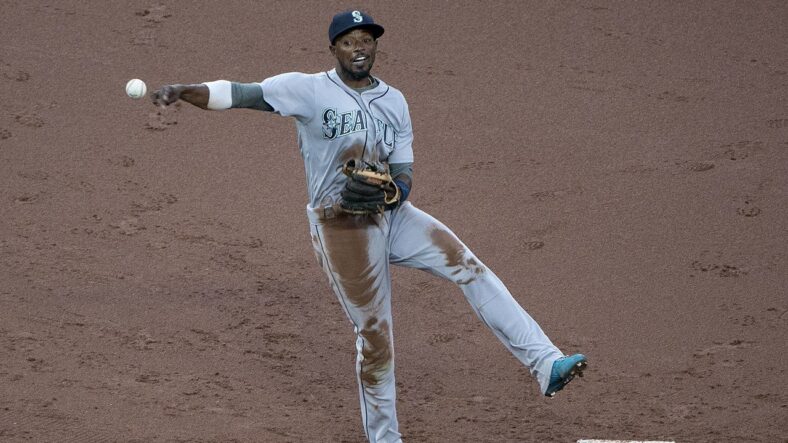Seattle Mariners: Dee Gordon is the odd man out

The Seattle Mariners are in a quandary with Dee Gordon. He’s squeezed out of a starting position, but too expensive to sit.
Dee Gordon has been somewhat of an enigma since the Seattle Mariners traded for him in December 2017. He does many things on the field very well. The problem is he doesn’t do them often enough to be a consistent threat.
With his natural speed on the base paths, Gordon is a prime candidate to be a leadoff hitter. If only that were the only criteria. What he does at the plate screams “end of the batting order.” His career on-base percentage is .320, but only a putrid .295 in two seasons with the Seattle Mariners.
Not enough bang for the buck
There is a reason why his OBP is so bad. Gordon swings at almost every pitch in his general direction. That wouldn’t be so bad if he connected more often. Last season, the second baseman had a strikeout to walk ratio of 5.2-1. For comparison, Eugenio Suarez of the Cincinnati Reds led the National League with 187 whiffs in 2019. His K-BB rate, however, was almost half of Gordon’s at 2.7-1.
As an M’s player Gordon has a career .271 batting average. That isn’t good enough to carry him at the top of the batting order. Mallex Smith had a rough transition to Seattle last year, he only hit .227, but still had a better OBP. The two seasons prior, Smith had a .287 BA and .354 OBP. Only once in his career has Gordon reached base at a higher clip.
Maybe it’s psychological. Batting out of the number nine slot last season, Gordon put up a slash of .331/.353/.427/.780. Those are fantastic numbers for a ninth-place hitter. Most teams would kill for that kind of production. He also works hard, can play several positions, if necessary, and is a good teammate.
The difference between the top teams and Seattle is that the Mariners are paying Gordon about $14M per season through 2021 for it. As a “non-big-spending” team, committing 13.82 percent of the payroll to what Gordon delivers is a poor use of financial resources. Even the Yankees don’t pay that much money, especially as a percentage of team payroll, for the last batter on the lineup card.
No room on the diamond
Also, working against Gordon is that he’s no longer the Seattle Mariners best option to play second base. After an excellent run in his September call-up, Shed Long has won the job. He’s now at the top of the M’s depth chart at second.
With Smith in center, and Long at second, the only other options for Gordon are the corner outfield slots. The Mariners are committed to younger players, so a move to either left or right field is doubtful. So is a regular turn at DH. Seattle needs the power Daniel Vogelbach and Mitch Haniger supply in the middle of the order.
Without a regular position, Dee Gordon has become an overpriced utility player and insurance policy. A luxury the Seattle Mariners can’t afford. At this point, GM Jerry DiPoto might as well wait to see if a contender has a key injury so he can ship Gordon someplace else for some much-needed pitching help. If there is a 2020 season.
What do you think about Dee Gordon’s role with the Seattle Mariners? Let us know in the comments section below or on social media.
